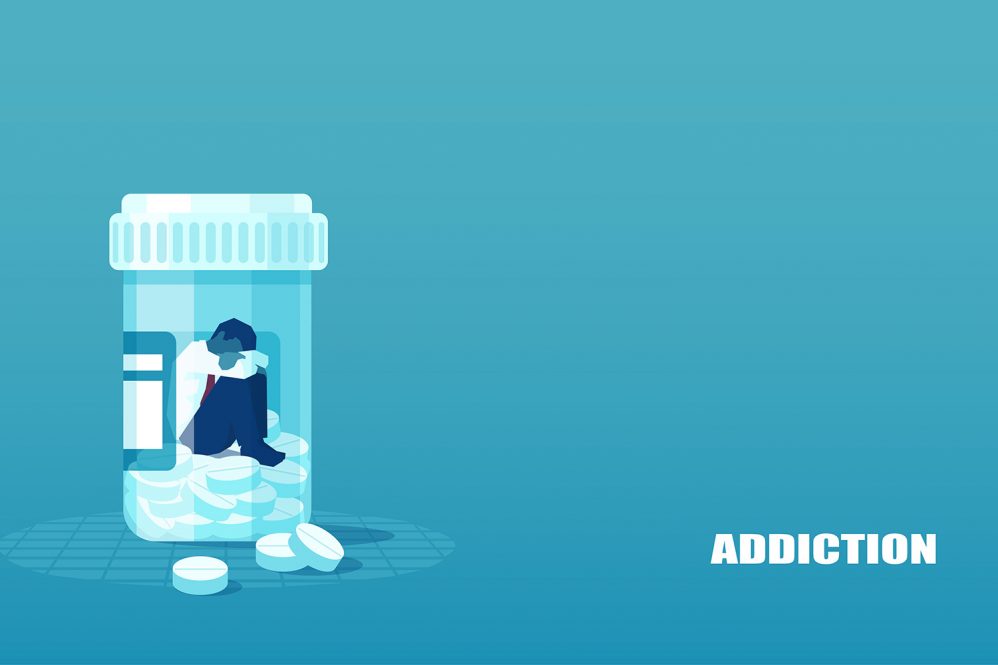UConn Today sat down with Dr. Lakshit Jain, clinical associate professor in the Department of Psychiatry at UConn Health, to learn more about what’s really involved in opioid addiction withdrawal and what those suffering from opioid use disorder and their loved ones really need to know to remain safe and ensure they are receiving the proper care. Jain, along with UConn Health co-authors Dr. Vania Modesto-Lowe and former psychiatry resident Dr. Roberto León-Barriera, just had a letter to the editor published in The Primary Care Companion for CNS Disorders entitled “Mindfulness Training in Opioid Withdrawal: Does It Help?”

Q: What is opioid use disorder?
A: Opioid use disorder (OUD) is not just an individual using a lot of opioids to get ‘high’; it refers to a problematic pattern of opioid use leading to clinically significant impairment or distress, as manifested by persistent desire or unsuccessful efforts to cut down opioid use, making a lot of efforts and spending a lot of time in activities necessary to obtain the opioid, use the opioid, or recover from its effects; strong cravings/desire/urges to use; failing to fulfill major life obligations at work, school, or home (losing job, dropping out, etc.); continued use despite having persistent or recurrent social or interpersonal problems (divorce, separation, losing custody of their child etc.); using opioids in dangerous situations (driving while intoxicated etc.); and giving up important social, occupational, or recreational activities in order to use opioids.
Q: How prevalent is OUD in the U.S.?
A: Opioid use disorder in the U.S. has been a triple wave phenomenon driven by the increasing popularity of prescription opioids, heroin and synthetic opioids respectively. This is often interpreted as people developing an opioid use disorder as they were receiving opioid prescriptions from their healthcare provider or stole opioid prescriptions from a relative receiving them from a provider; and then turning to heroin as the prescriptions expired or were stopped.
In the U.S., 5.7 million people (2.1 percent of people aged 12 or older) were estimated in 2019 to have used heroin at some point in their lives and 431,000 (0.2 percent) reported use in the last month. Between 2002 and 2018, the prevalence of heroin use and heroin use disorder nearly doubled.
Q: How dangerous have illegal opioids become?
A: Starting in 2013, illegally manufactured fentanyl (IMF) began gaining popularity in the U.S., both in its pure form and mixed with heroin as fentanyl is 30–40 times more potent by weight than heroin and is cheaper. Fentanyl has led to a significant decline in cost of opioids, and as the high potency of IMF can lead to rapid overdose, evidenced by 56% of the deceased being pulseless on arrival of first responders.
This rise in opioid use disorder has led to a national pandemic of opioid overdose deaths, with more than 100,000 estimated drug overdose deaths in a 12-month period for the first time with over 64% of these deaths involving fentanyl. According to the CDC, the age-adjusted rate of overdose deaths nationally increased significantly by 9.6% from 2016 (19.8 per 100,000) to 2017 (21.7 per 100,000). Opioids—mainly synthetic opioids other than methadone—are currently the main driver of drug overdose deaths. Opioids were involved in 47,600 overdose deaths nationally in 2017. This number represents 67.8% of all drug overdose deaths in the United States.
Q: What do patient’s report commonly as challenging withdrawal symptoms or what can withdrawal from opioids feels like?
A: Patients experiencing opioid withdrawal typically experience extremely strong flu-like symptoms, and some refer to it as “super flu” or “a flu on steroids”. These include severe muscle pain, tearing up, runny nose, nausea, vomiting, abdominal cramping, diarrhea and restlessness. These are made worse by sustained and consistent strong cravings for an opioid.
Opioid withdrawal begins almost immediately if naloxone is used to revive someone on the street or in an ER, and signs and symptoms of withdrawal begin as early as 4 to 12 hours after the last dose of a short-acting opioid and are often delayed 24 to 48 hours after cessation of a longer-acting opioid such as methadone. Withdrawal symptoms typically peak within 24 to 48 hours of onset and persist for several days with short-acting agents and up to two weeks with methadone.
Severe withdrawal can lead to an increase in heart rate, blood pressure, and respiratory rate. Severe vomiting and diarrhea can lead to fluid loss and low blood pressure. While these can be managed, the cravings continue to get worse, compelling the patient to search for more opioids and to consume them to decrease the cravings.
Q: Where should patients seek help?
A: Patients suffering from mild to moderate opioid withdrawal should reach out to their primary care providers, as there are ways to help patients participate in treatment with medications like methadone and buprenorphine.
If the withdrawal is severe (racing heart, fainting, difficulty breathing etc.) they should present to the nearest ER.
Q: What treatments are proven to be most effective?
A: Treatment for opioid use disorder is multifocal, involving several treatment strategies often utilized in conjunction in a specialized treatment facility. These include:
- Pharmacologic management — these include opioid agonists (buprenorphine or methadone) and opioid antagonists (i.e., naltrexone). Buprenorphine is preferred for mild to moderate opioid use disorder and Methadone is preferred for individuals with high tolerance (people that use high doses of opioids to achieve the desired effect). In individuals who cannot or will not take agonist treatment, naltrexone is a reasonable alternative; however, individuals who will be treated with naltrexone need medically supervised withdrawal before initiation of an antagonist.
- Psychotherapy – this includes the following interventions:
- Counseling or cognitive-behavioral therapy (CBT), including variants such as acceptance and commitment therapy and Motivational interviewing.
- Behavioral interventions like Contingency management that uses incentives and other reinforcements to increase treatment engagement and decrease substance use. Contingency management is typically added to other interventions, such as (CBT). It has generally been found to be efficacious in opioid use disorder.
- Mutual help groups such as Narcotics Anonymous or Methadone Anonymous.
- Training or involvement in communities like Medication-Assisted Recovery Services.
Q: Can mindfulness help patients battling withdrawal from opioids?
A: In some addiction settings (inpatient and outpatient), patients are being exposed to mindfulness training (MT) in individual and group settings to decrease stress, cravings and cue-reactivity. MT also appears to have positive effects on various types of pain, which includes pain in patients with addiction. Anecdotal evidence suggests that MT can be particularly helpful during withdrawal states, despite scarce empirical data to support this view.
Q: Along with prevention, what new promising treatments are on the horizon for helping curb our nation’s opioid addiction epidemic?
A: A new implant called Probuphine was approved by U.S. Food and Drug Administration (FDA) in 2016. It consists of a one-inch rod that is inserted in the inside of the upper arm by a physician. This implant delivers a constant dose of buprenorphine that can last up to six months with multiple rods.
Also, in 2017 the FDA approved Sublocade, which is a once-monthly injectable formulation of buprenorphine. Patients that have been on a stable dose of buprenorphine treatment for a minimum of seven days can choose to receive this once monthly injection. In 2018 FDA approved Lucemyra (lofexidine hydrochloride) for reduction of severity of opioid withdrawal symptoms and to facilitate abrupt discontinuation of opioids in adults. It works via a mechanism similar to clonidine.
In addition to new treatments, the Department of Health and Human Services (HHS) is releasing new buprenorphine practice guidelines that decrease barriers for providers so that they can treat more people. Also, in 2018, the National Institutes of Health (NIH) launched the Helping to End Addiction Long-term Initiative (NIH HEAL Initiative). This is an “aggressive, trans-agency effort to speed scientific solutions to stem the national opioid public health crisis”. It aims to provide support for several institutes to accelerate research to address this public health emergency from all angles.



